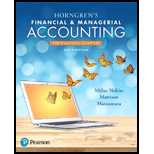
1.
Effective-interest amortization method:
Effective-interest amortization method it is an amortization model that apportions the amount of bond discount or premium based on the market interest rate.
In this method, first, interest expense is calculated based on the current carrying amount and market interest rate and cash interest payment is calculated based on the face value amount and stated interest rate and then, the different between the cash interest payment and interest expense is amortized as a decrease to the discount or premium.
Amortization Schedule:
An amortization schedule is a table that shows the details of each loan payment allocated between the principal amount and the overdue interest along with the beginning and ending balance of the loan. From the amortization schedule of the loan, the periodical interest expense, total interest expense and total payment made are known.
To prepare: An amortization table using the effective interest amortization method for the first two semiannual interest periods.
2.
To Journalize: Issuance of the bonds.
To Journalize: First semiannual interest payment and amortization of the bonds.
To Journalize: Second semiannual interest payment and amortization of the bonds.
Want to see the full answer?
Check out a sample textbook solution
Chapter 12 Solutions
Horngren's Financial & Managerial Accounting, The Financial Chapters (6th Edition)
- The principle of matching costs with revenues is known as _____ principle. a. Cost b. Matching c. Consistency d. Revenuearrow_forwardDoom Ltd uses predetermined overhead rates based on labor hours. The monthly budgeted overhead is $470,000 and the budgeted labor hours were 20,000. During the month the company worked a total of 70,000 labor hours and actual overheads totaled $230,000. The overhead at the end of the month would therefore be$?arrow_forwardI am trying to find the accurate solution to this general accounting problem with appropriate explanations.arrow_forward
- The main function of cost accounting is _______ reporting a. Internal b. External c. Government d. Bankarrow_forwardDirect materials cost is Rs. 80,000. Direct labor cost is Rs. 60,000. Factory overhead is Rs. 90,000. Beginning goods in process were Rs. 15,000. The cost of goods manufactured is Rs. 245,000. What is the cost assigned to the ending goods in process?arrow_forwardHarris Company assigns overhead cost to jobs on the basis of 120% of direct labor cost. The job cost sheet for Job 205 includes $18,500 in direct materials cost and $15,200 in direct labor cost. A total of 2,300 units were produced in Job 205. Required: a. What is the total manufacturing cost assigned to Job 205? b. What is the unit product cost for Job 205?arrow_forward
- According to CIMA, England, “the technique and process of ascertaining cost” is called a. Costing b. Cost Accounting c. Cost Accountancy d. Costarrow_forwardWhich of the following manufacturers is most likely to use a job order cost accounting system? A soft drink producer A flour mill A textile mill A builder of offshore oil rigsarrow_forwardPlease explain the solution to this general accounting problem with accurate principles.arrow_forward

 AccountingAccountingISBN:9781337272094Author:WARREN, Carl S., Reeve, James M., Duchac, Jonathan E.Publisher:Cengage Learning,
AccountingAccountingISBN:9781337272094Author:WARREN, Carl S., Reeve, James M., Duchac, Jonathan E.Publisher:Cengage Learning, Accounting Information SystemsAccountingISBN:9781337619202Author:Hall, James A.Publisher:Cengage Learning,
Accounting Information SystemsAccountingISBN:9781337619202Author:Hall, James A.Publisher:Cengage Learning, Horngren's Cost Accounting: A Managerial Emphasis...AccountingISBN:9780134475585Author:Srikant M. Datar, Madhav V. RajanPublisher:PEARSON
Horngren's Cost Accounting: A Managerial Emphasis...AccountingISBN:9780134475585Author:Srikant M. Datar, Madhav V. RajanPublisher:PEARSON Intermediate AccountingAccountingISBN:9781259722660Author:J. David Spiceland, Mark W. Nelson, Wayne M ThomasPublisher:McGraw-Hill Education
Intermediate AccountingAccountingISBN:9781259722660Author:J. David Spiceland, Mark W. Nelson, Wayne M ThomasPublisher:McGraw-Hill Education Financial and Managerial AccountingAccountingISBN:9781259726705Author:John J Wild, Ken W. Shaw, Barbara Chiappetta Fundamental Accounting PrinciplesPublisher:McGraw-Hill Education
Financial and Managerial AccountingAccountingISBN:9781259726705Author:John J Wild, Ken W. Shaw, Barbara Chiappetta Fundamental Accounting PrinciplesPublisher:McGraw-Hill Education





